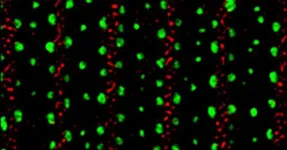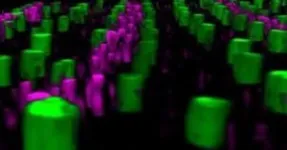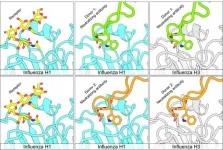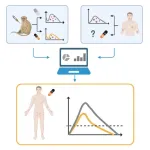(Press-News.org) Species throughout the animal kingdom feature vital interfaces between the outermost layers of their bodies and the environment. Intricate microscopic structures—featured on the outer skin layers of humans, as one example—are known to assemble in matrix patterns.
But how these complex structures, known as apical extracellular matrices (aECMs) are assembled into elaborately woven architectures has remained an elusive question.
Now, following years of research and the power of a technologically advanced instrument, University of California San Diego scientists have unraveled the underpinnings of such matrices in a tiny nematode. The roundworm Caenorhabditis elegans has been studied extensively for decades due to its transparent structure that allows researchers to peer inside its body and examine its skin.
Described in the journal Nature Communications, School of Biological Sciences researchers have now deciphered the assemblage of aECM patterns in roundworms at the nanoscale. A powerful, super-resolution microscope helped reveal previously unseen patterns related to columns, known as struts, that are key to the proper development and functioning of aECMs.
“Struts are like tiny pillars that connect the different layers of the matrix and serve as a type of scaffolding,” said Andrew Chisholm, a professor in the School of Biological Sciences and the paper’s senior author.
Although roundworms serve as a model organism for laboratory studies due to their simple, transparent bodies, below the surface they feature intricate architectures. They also have nearly 20,000 genes, not unlike the number of human genes, and therefore provide lessons on structure and function of more advanced organisms.
Focusing on the roundworm exoskeleton known as the cuticle, the researchers found that defects in struts result in unnatural layer swelling, or “blistering.” Within the cuticle layer, the research study focused on collagens, which are the most abundant family of proteins in our bodies and help keep bodily materials conjoined.
“The struts hold the critical layers together,” said Chisholm. “Without them, the layers separate and cause disorders such as blistering. In blistering mutants you don’t see any struts.”
Conventional laboratory instruments had previously imaged struts without detail, often resulting in undefined blobs. But through Biological Sciences Assistant Professor Andreas Ernst’s laboratory they accessed advanced instrumentation—known as 3D-structured illumination super resolution microscopy (3D-SIM)—which put the struts into stunning focus and allowed their functions to be more easily defined. The researchers were then able to solve the nanoscale organization of struts and previously undocumented levels of patterning in the cuticle layer.
“We could see exactly where these proteins were going in the matrix,” said Chisholm. “This is potentially a paradigm for how the matrix assembles into very complex structures and very intricate patterning.”
The two first authors, Jennifer Adams (senior research associate) and Murugesan Pooranachithra (postdoctoral fellow), contributed equally to the paper. Other coauthors are Erin Jyo, Sherry Li Zheng, Alexandr Goncharov, Jennifer Crew, James Kramer, Professor of Neurobiology Yishi Jin, Assistant Professor of Cell and Developmental Biology Andreas Ernst and Andrew Chisholm.
Sherry Zheng was a UC San Diego Triton Research and Experiential Learning Scholar and received the Gabriele Wienhausen Biological Sciences Scholarship.
END
Inside the matrix: Nanoscale patterns revealed within model research organism
Advanced instrument provides new 3D views of worm’s exoskeleton and clues about how skin layers are bound together
2023-12-21
ELSE PRESS RELEASES FROM THIS DATE:
Urology treatment studies show increased reporting of harmful effects
2023-12-21
Waltham — December 11, 2023 —
In recent years, clinical trial reports in major urology journals have been more likely to include data on harmful effects of treatments, reports a study in the January issue of The Journal of Urology®, an Official Journal of the American Urological Association (AUA). The journal is published in the Lippincott portfolio by Wolters Kluwer.
"Our analysis finds a marked increase in reporting of potential harms in randomized treatment trials ...
New type of antibody shows promise against multiple forms of flu virus
2023-12-21
Researchers have identified a previously unrecognized class of antibodies—immune system proteins that protect against disease—that appear capable of neutralizing multiple forms of flu virus. These findings, which could contribute to development of more broadly protective flu vaccines, will publish December 21st by Holly Simmons of the University of Pittsburgh School of Medicine, US, and colleagues in the open access journal PLOS Biology.
A flu vaccine prompts the immune system to make antibodies that can bind to a viral protein ...
Despite use of tecovirimat since the beginning of the 2022 mpox outbreak, few data have been published on its antiviral effect in humans
2023-12-21
Despite use of tecovirimat since the beginning of the 2022 mpox outbreak, few data have been published on its antiviral effect in humans; this study predicts the impact of early tecovirimat administration on the time to viral clearance in patients with mpox infection, using an integrative modeling approach combining pre-clinical and clinical data
#####
In your coverage, please use this URL to provide access to the freely available paper in PLOS Biology: http://journals.plos.org/plosbiology/article?id=10.1371/journal.pbio.3002249
Article Title: Early administration of tecovirimat shortens the time to mpox clearance ...
How technology and economics can help save endangered species
2023-12-21
COLUMBUS, Ohio – A lot has changed in the world since the Endangered Species Act (ESA) was enacted 50 years ago in December 1973.
Two researchers at The Ohio State University were among a group of experts invited by the journal Science to discuss how the ESA has evolved and what its future might hold.
Tanya Berger-Wolf, faculty director of Ohio State’s Translational Data Analytics Institute, led a group that wrote on “Sustainable, trustworthy, human-technology partnership.” Amy Ando, professor and chair of the university’s Department of Agricultural, Environmental, and Development Economics, ...
Sniffing women’s tears reduces aggressive behavior in men
2023-12-21
New research, publishing December 21st in the open access journal in PLOS Biology, shows that tears from women contain chemicals that block aggression in men. The study led by Shani Agron at the Weizmann Institute of Science, Israel, finds that sniffing tears leads to reduced brain activity related to aggression, which results is less aggressive behavior.
Male aggression in rodents is known to be blocked when they smell female tears. This is an example of social chemosignaling, a process that is common in animals but less common—or less understood—in humans. To determine whether tears have the same affect in people, ...
Polar bear fur-inspired fibers offer exceptional thermal insulation, tested in a sweater
2023-12-21
Inspired by the structure of polar bear fur, researchers present a knittable aerogel fiber with exceptional thermal and mechanical properties. The fibers are washable, dyeable, durable, and well-suited to be used in advanced textiles. This allowed the researchers to test them in a sweater that demonstrated impressive thermal insulation, among other features. Aerogels are an ideal material for thermal insulation. They demonstrate high porosity and extremely low thermal conductivity. However, the application of ...
Racial disparities in health motivate more support for social action than other racial disparities
2023-12-21
Racial disparities related to health and physical well-being motivate Americans to take action for social change more than racial disparities related to other factors, like economics, a new study finds. This is because health-related racial inequalities are perceived to be more unjust. The results suggest that framing racial disparities to tap into feelings of moral injustice may motivate policy reform – a finding of potential interest to policymakers, social movements, and citizens seeking to gain support for actions to reduce racial inequality. “…this work can help us understand ...
Octopus DNA reveals West Antarctic Ice Sheet collapse during Last Interglacial
2023-12-21
Genetic analyses of an Antarctic octopus show that the West Antarctic Ice Sheet (WAIS) collapsed during the Last Interglacial ~129,000 to 116,000 years ago when temperatures were only about 1 degree Celsius (°C) warmer than preindustrial levels. The findings suggest that WAIS collapse and resultant sea-level rise could be caused by even the minimal temperature rises projected by the most optimistic climate change mitigation plans. Climate change is driving unprecedented change to Earth’s cryosphere. The West Antarctic Ice Sheet is considered particularly vulnerable to warming ...
Can cryptocurrencies be legal tender? A case study from El Salvador
2023-12-21
In El Salvador, preference for cash and privacy fears deterred the widespread adoption of Bitcoin as an everyday currency, researchers report. The findings suggest that policies incentivizing cryptocurrency adoption as legal tender will likely fail unless populations are financially literate and already trust digital currencies. The introduction of digital currencies is one of the most important developments in monetary economics in the last decade. Unlike traditional digital currencies, which rely on central authorities such as governments or banks governed by regulations ...
Researchers map how measles virus spreads in human brain
2023-12-21
ROCHESTER, Minn. — Mayo Clinic researchers mapped how the measles virus mutated and spread in the brain of a person who succumbed to a rare, lethal brain disease. New cases of this disease, which is a complication of the measles virus, may occur as measles reemerges among the unvaccinated, say researchers.
Using the latest tools in genetic sequencing, researchers at Mayo Clinic reconstructed how a collective of viral genomes colonized a human brain. The virus acquired distinct mutations that drove the spread of the virus from the frontal cortex outward.
"Our study provides compelling data that ...
LAST 30 PRESS RELEASES:
Numbers in our sights affect how we perceive space
SIMJ announces global collaborative book project in commemoration of its 75th anniversary
Air pollution exposure and birth weight
Obstructive sleep apnea risk and mental health conditions among older adults
How talking slows eye movements behind the wheel
The Ceramic Society of Japan’s Oxoate Ceramics Research Association launches new international book project
Heart-brain connection: international study reveals the role of the vagus nerve in keeping the heart young
Researchers identify Rb1 as a predictive biomarker for a new therapeutic strategy in some breast cancers
Survey reveals ethical gaps slowing AI adoption in pediatric surgery
Stimulant ADHD medications work differently than thought
AI overestimates how smart people are, according to HSE economists
HSE researchers create genome-wide map of quadruplexes
Scientists boost cell "powerhouses" to burn more calories
Automatic label checking: The missing step in making reliable medical AI
Low daily alcohol intake linked to 50% heightened mouth cancer risk in India
American Meteorological Society announces Rick Spinrad as 2026 President-Elect
Biomass-based carbon capture spotlighted in newly released global climate webinar recording
Illuminating invisible nano pollutants: advanced bioimaging tracks the full journey of emerging nanoscale contaminants in living systems
How does age affect recovery from spinal cord injury?
Novel AI tool offers prognosis for patients with head and neck cancer
Fathers’ microplastic exposure tied to their children’s metabolic problems
Research validates laboratory model for studying high-grade serous ovarian cancer
SIR 2026 delivers transformative breakthroughs in minimally invasive medicine to improve patient care
Stem Cell Reports most downloaded papers of 2025 highlight the breadth and impact of stem cell research
Oxford-led study estimates NHS spends around 3% of its primary and secondary care budget on the health impacts of heat and cold in England
A researcher’s long quest leads to a smart composite breakthrough
Urban wild bees act as “microbial sensors” of city health.
New study finds where you live affects recovery after a hip fracture
Forecasting the impact of fully automated vehicle adoption on US road traffic injuries
Alcohol-related hospitalizations from 2016 to 2022
[Press-News.org] Inside the matrix: Nanoscale patterns revealed within model research organismAdvanced instrument provides new 3D views of worm’s exoskeleton and clues about how skin layers are bound together




